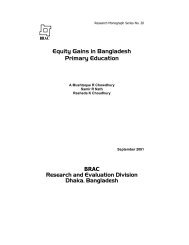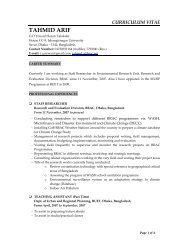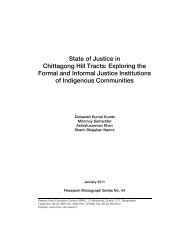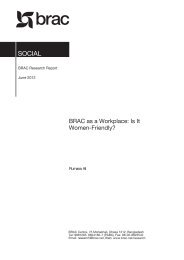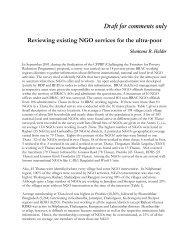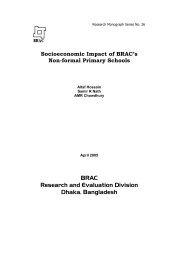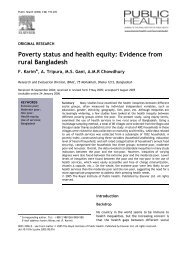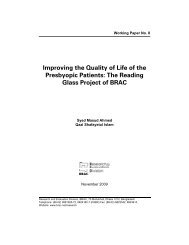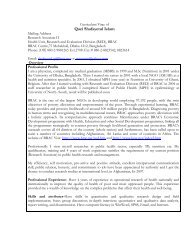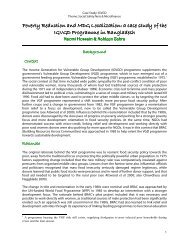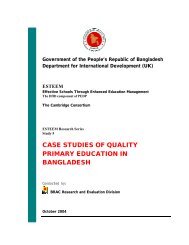Combining health and social protection measures to reach the ultra ...
Combining health and social protection measures to reach the ultra ...
Combining health and social protection measures to reach the ultra ...
You also want an ePaper? Increase the reach of your titles
YUMPU automatically turns print PDFs into web optimized ePapers that Google loves.
Decision-making<br />
Equitable access: good<br />
intentions are not enough<br />
Article by Robert Wells (pictured) <strong>and</strong> Judith Whitworth<br />
Most countries do not have universal <strong>health</strong> insurance<br />
<strong>and</strong> for most people living in countries without<br />
universal access, particularly <strong>the</strong> poor, illness is a<br />
substantial financial burden, <strong>and</strong> indeed often a crippling<br />
burden. Paradoxically, a far greater proportion of out-ofpocket<br />
spending occurs in those countries least able <strong>to</strong> afford<br />
it. Inevitably, <strong>health</strong> care, far from being a basic human right,<br />
is simply beyond <strong>the</strong> <strong>reach</strong> of many.<br />
As a proportion of gross domestic product (GDP),<br />
developed countries spend around 8–9% on <strong>health</strong> (this<br />
includes both government <strong>and</strong> private spending) 1 . In contrast,<br />
in lower- <strong>and</strong> middle-income countries’ proportional<br />
expenditure is usually far less, e.g. Sri Lanka spent 1.3% <strong>and</strong><br />
India 0.9% of GDP in 2004 2 . In Ghana per capita spending<br />
on <strong>health</strong> was estimated as US$ 8 per person per year in<br />
2004 2 . This contrasts with <strong>the</strong> United States figure of around<br />
US$ 6100 in 2004. The Macroeconomic Commission on<br />
Health considered US$ 30–40 as <strong>the</strong> minimum necessary for<br />
basic <strong>health</strong> interventions 2 . These figures reflect in part<br />
relative wealth of countries, but clearly also are dependent on<br />
spending priorities of governments. Thus in many countries<br />
basic <strong>health</strong> interventions for all are not assured.<br />
Some countries, most particularly wealthier countries, have<br />
schemes/systems for universal <strong>health</strong> insurance e.g.<br />
Australia, UK, many European countries. Ironically <strong>the</strong><br />
world’s richest nation, <strong>the</strong> USA, st<strong>and</strong>s out both as not having<br />
a system of universal <strong>health</strong> <strong>and</strong> as spending absolutely <strong>and</strong><br />
proportionally much more on <strong>health</strong> than any o<strong>the</strong>r country.<br />
Developed countries with comprehensive universal <strong>health</strong><br />
insurance tend <strong>to</strong> spend less on <strong>health</strong> than those without<br />
such systems such as <strong>the</strong> USA 1 or with more limited universal<br />
coverage (such as Canada <strong>and</strong> Australia), although <strong>health</strong><br />
outcomes are equivalent or better, pointing out <strong>the</strong> desirability<br />
of universal access. The USA spends nearly twice as much as<br />
<strong>the</strong> UK without any comparable improvement in <strong>health</strong><br />
outcomes, <strong>and</strong> it has been estimated that at least some<br />
premature mortality in <strong>the</strong> USA represents inadequate<br />
access 3 .<br />
Universal access is generally regarded as a highly desirable<br />
policy. Yet even in this context, <strong>the</strong>re are often inequities,<br />
which may not be intended. For example, in Australia fac<strong>to</strong>rs<br />
which inhibit access <strong>and</strong> introduce inequity include uneven<br />
geographic distribution of <strong>health</strong> services; unequal capacity <strong>to</strong><br />
afford “out-of-pocket” expenses (such as patient copayments,<br />
travel, or time off work); <strong>the</strong> limited range of<br />
available services e.g., shortages in some speciality areas<br />
such as geriatrics, ophthalmology; <strong>the</strong> global problem of<br />
insufficient workforce which particularly affects rural<br />
Australia; <strong>and</strong> long waiting times for high dem<strong>and</strong> services,<br />
which can be bypassed by <strong>the</strong> rich (via <strong>the</strong> private sec<strong>to</strong>r) but<br />
not by <strong>the</strong> poor.<br />
These problems are magnified in lower- <strong>and</strong> middleincome<br />
countries, for example, in Tanzania a 1997 scheme<br />
<strong>to</strong> implement evidence based <strong>health</strong> plans at an estimated<br />
cost of US$ 2 per capita was limited by inadequacy of<br />
infrastructure <strong>and</strong> capacity 4 . These difficulties have been<br />
widely recognized <strong>and</strong> are seen in particular where increased<br />
spending on vertical programmes in areas of limited capacity<br />
<strong>and</strong> infrastructure have led <strong>to</strong> redirection <strong>and</strong> fur<strong>the</strong>r<br />
weakening of resources available <strong>to</strong> <strong>the</strong> system as a whole.<br />
There are fur<strong>the</strong>r difficult questions around our<br />
underst<strong>and</strong>ing of what is equitable. For example, Australia<br />
spends around 1.5 times more per head on <strong>health</strong> care for its<br />
indigenous population than for non-indigenous people.<br />
However, <strong>the</strong> <strong>health</strong> status of indigenous people is appalling;<br />
with life expectancy almost 20 years lower than for <strong>the</strong> nonindigenous<br />
population. If expenditure is considered in terms<br />
of disease burden <strong>the</strong>n indigenous <strong>health</strong> is significantly<br />
under-funded. Indigenous people living in remote areas have<br />
10–20 times higher death rates than non-indigenous<br />
Australians from diseases such as diabetes, cervical cancer,<br />
respira<strong>to</strong>ry disease <strong>and</strong> infections 5 . Suggestions for <strong>the</strong><br />
additional spending required <strong>to</strong> improve <strong>health</strong> status for<br />
indigenous people range from two <strong>to</strong> three times that for nonindigenous<br />
people but <strong>the</strong>se figures seem <strong>to</strong> have no firm<br />
basis <strong>and</strong> <strong>the</strong>refore would provide no guarantee of achieving<br />
a measurable improvement. There would probably be a need<br />
also for a concomitant proportional increase on <strong>social</strong> <strong>and</strong><br />
infrastructure support spending for indigenous people.<br />
The research agenda<br />
What <strong>the</strong>n are <strong>the</strong> research questions around equitable<br />
access? How long is a piece of string?<br />
For example:<br />
1. What do we mean by equity? Which aspect has primacy –<br />
dollars spent or <strong>health</strong> status or <strong>health</strong> outcomes?<br />
2. How do we determine what is a reasonable amount <strong>to</strong><br />
spend (or invest)? How can this best be contextualized <strong>and</strong><br />
Global Forum Update on Research for Health Volume 4 ✜ 151



